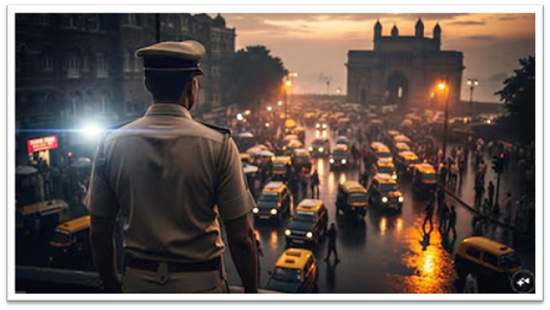
Maharashtra Government to Redevelop 75 Plots and Build 40,000 New Homes to End Mumbai Police Housing Crisis
For decades, Mumbai’s police force—tasked with protecting one of the world’s most complex urban ecosystems—has struggled with a problem that rarely makes headlines: inadequate housing. Officers responsible for the city’s safety often live in crumbling structures or commute for hours from distant suburbs. Now, the Maharashtra government has taken a decisive step toward fixing this long-neglected issue by announcing the redevelopment of 75 plots across Mumbai to construct 40,000 new residential units for police personnel.
This initiative, described by senior officials as one of the state’s largest institutional housing efforts, aims to tackle both the shortage and deterioration of police housing that has persisted for decades. It is a move that ties together administrative reform, urban planning, and public welfare under one framework.
The Scale of the Challenge
Mumbai’s police force comprises over 51,000 personnel, but existing housing falls drastically short. According to government data, the city has only 19,762 police quarters, of which 16,958 were built during the British era. Many of these are now structurally unsafe and nearly uninhabitable.
This mismatch has forced thousands of officers to live in distant towns such as Virar, Palghar, Kalyan, Karjat, Kasara, and Panvel, commuting as much as 80 to 100 kilometres daily. The impact on morale and operational efficiency is significant. Long commutes mean fatigue, delayed reporting, and slower emergency response—all of which directly affect law and order management in a city that runs on precision and speed.
The state’s Home Department, in its recent government resolution (GR), acknowledges the link between inadequate housing and reduced law enforcement readiness, describing it not as a welfare issue but an infrastructure deficiency that undermines public safety.
The New Blueprint: A Multi-Agency Collaboration
To ensure the project’s success, the Maharashtra government has formed a 15-member high-level committee headed by the Additional Chief Secretary (Home Department). The committee’s mandate is to assess the current state of police colonies, explore redevelopment models, and design a comprehensive blueprint for the construction of modern, self-sustained housing townships.
The Managing Director of the Maharashtra State Infrastructure Development Corporation (MSIDC) will serve as the member-secretary, indicating that the government may engage private developers through public-private partnerships (PPPs) to expedite construction.
The committee’s composition underscores its strategic importance and the level of inter-departmental coordination required. It includes:
• The Commissioner of Police, Mumbai
• The Commissioner of the Brihanmumbai Municipal Corporation (BMC)
• The Vice President and CEO of MHADA
• The CEO of the Slum Rehabilitation Authority (SRA)
• Senior officials from the Public Works, Finance, Housing, Planning, and Urban Development Departments
• The District Collectors of Mumbai City and Suburban Districts
• Ashwini Bhide, Additional Chief Secretary in the Chief Minister’s Office (CMO), signalling top-level administrative support
Such an empowered panel ensures that the initiative will not be lost in bureaucratic loops but instead guided by data, design, and decisive action.
A Vision Beyond Bricks and Mortar
The plan’s focus extends beyond merely building homes. The vision is to create modern residential clusters with adequate infrastructure—green spaces, parking facilities, digital connectivity, and community services such as schools and health centres. These colonies will likely follow a township model, designed to foster a sense of community and ensure that police personnel remain close to their work zones.
This is more than a housing project—it’s a productivity intervention. Well-housed officers mean reduced fatigue, better response times, improved morale, and greater commitment to public duty.
Globally, police housing is recognized as a key determinant of performance. Studies from cities like London and Singapore have shown that when frontline workers live closer to their deployment zones, operational efficiency rises by 15–20%. Maharashtra’s new plan appears to embrace this evidence-based approach.
Administrative Reform with Urban Benefits
The redevelopment effort will also serve as a template for urban renewal. Many of Mumbai’s police plots are located in prime areas that have long been underutilized. Their redevelopment can rejuvenate neighbourhoods, improve land use efficiency, and enhance civic infrastructure through integrated planning with agencies like the BMC and MHADA.
By coupling institutional housing with city planning, the government aims to create a ripple effect—reducing commuter pressure on transport networks, optimizing land resources, and aligning with the broader “Ease of Living” agenda for essential service workers.
A Lesson in Governance and Prioritization
The inclusion of senior officials across departments—from finance to planning—underscores a larger shift in governance: viewing police welfare as an investment in state capacity rather than an administrative cost. In effect, this project positions housing as the foundation for effective policing, much like equipment, technology, or training.
By providing stable, dignified homes, the state strengthens its own institutional backbone. It signals that those who safeguard the city deserve to live securely within it.
Building the Future of Mumbai’s Law Enforcement
Mumbai is a city that faces complex, simultaneous challenges—ranging from cybercrime to disaster management. Addressing such risks requires a police force that is alert, motivated, and supported by modern infrastructure.
The 40,000-unit redevelopment plan is therefore not just a construction project—it’s a reform in motion, aligning infrastructure with human capital. If executed effectively, it could serve as a national model for housing essential public service personnel, including teachers, nurses, and sanitation workers.
The initiative marks a new chapter where public service meets public investment, and where governance meets gratitude. In rebuilding homes, Maharashtra is also rebuilding confidence—within its police force and among the citizens they serve.





